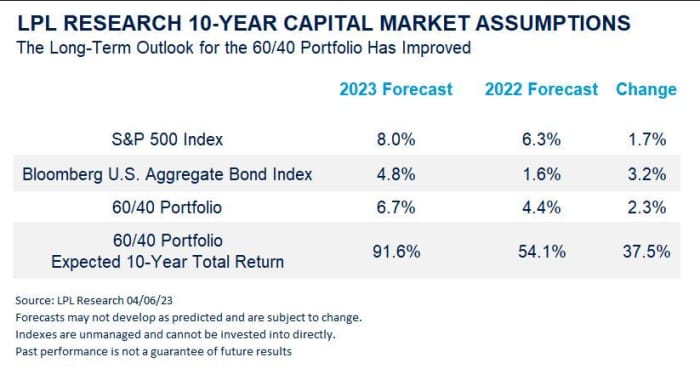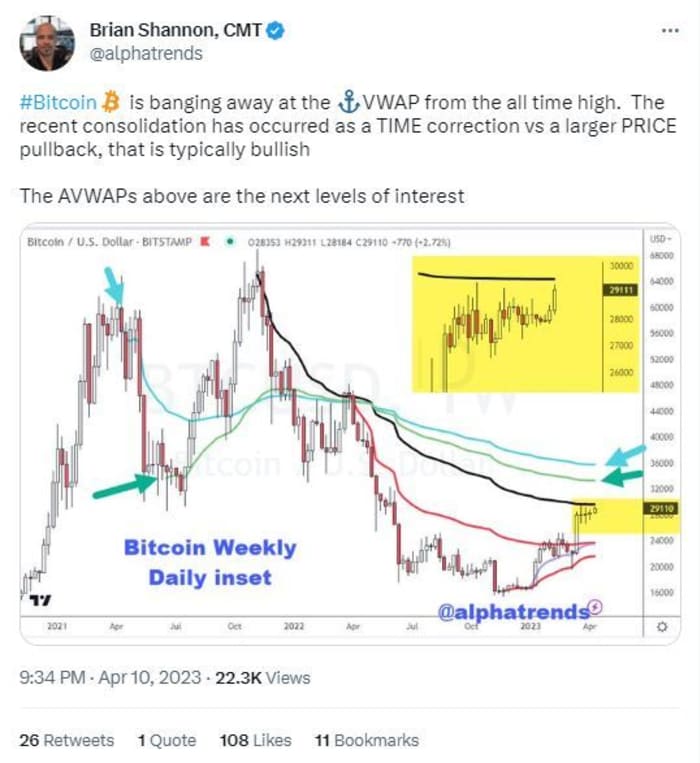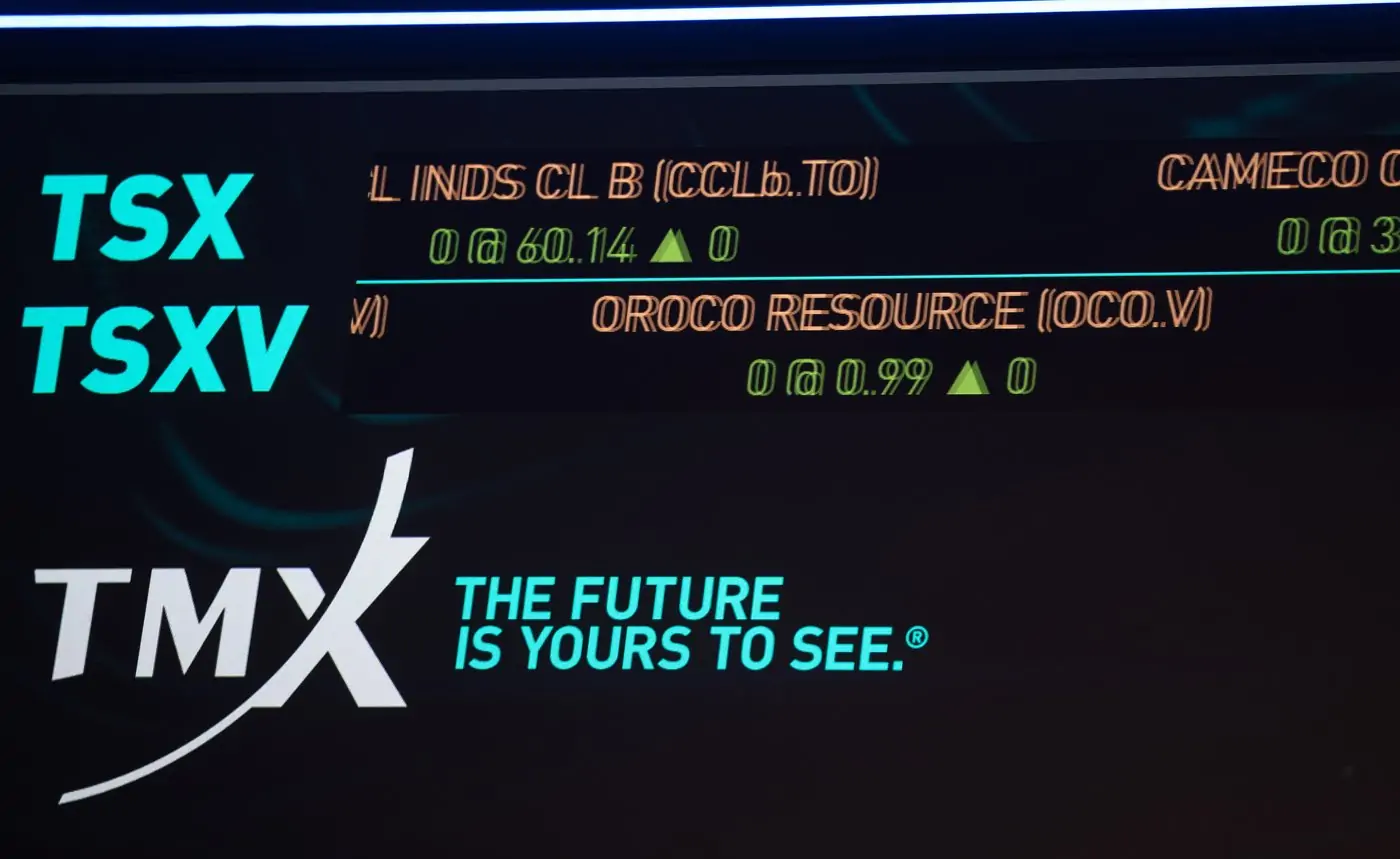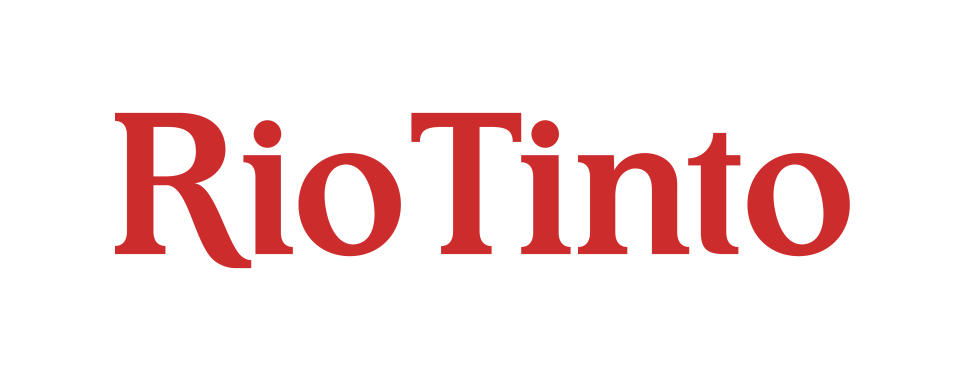Investment
Left for dead, this popular investment strategy is about to make a comeback
Tuesday’s stock setup is looking wobbly, a day ahead of mega consumer price data that could firm up or loosen growing consensus for another Fed rate hike next month.
An additional interest-rate rise might serve to entice more investors into money-market funds, investments that might have otherwise have gone into bonds or stocks.
That brings us to our call of the day, from LPL Financial’s asset allocation strategist Barry Gilbert, who says it’s time to reconsider a beaten-down, but once-popular investment strategy.
“There deservedly was a lot of hand-wringing about the death of the 60/40 portfolio in 2022, a portfolio of 60% stocks and 40% bonds,” Gilbert wrote in a note. “What was most surprising for the 60/40 in 2022, of course, was how spectacularly bonds failed to play their traditional role as a portfolio diversifier in a down market for equities.”
While investors are used to choppy paths to longer-term stock gains, he said they were stunned by bond volatility, of which 2022 delivered plenty. But things are starting to look brighter for the 60/40, he said.
“While the fourth quarter of 2022 and the first quarter of 2023 weren’t spectacular for the 60/40, using the total return for the S&P 500 index and the Bloomberg U.S. Aggregate Bond Index as our proxy for stocks and bonds, the 60/40 has been on solid footing the last two quarters, as seen in the chart below,” said Gilbert.
Looking ahead, he says investors can find even more reasons to reconsider the strategy.
“Looking at bonds from a tactical perspective, with higher starting yields, a Federal Reserve likely near the end of its rate hiking campaign, and inflation coming back down, not only do return prospects look brighter for bonds, we believe they have become more likely to return to their historical role of a portfolio diversifier in the event of an economic downturn,” said Gilbert.
On the equity side, he admits there is more uncertainty given Fed policy tends to act with a lag, but is also not anticipating a steeper downturn and doesn’t think markets will overreact to a modest one.
On a strategic time frame, LPL’s long-term stock and bond forecasts, based on the S&P 500 and the Bloomberg Aggregate as proxies, indicate improvement from last year to 2023. Stock valuations are still a bit elevated based on history, but did improve in the pullback, while the jump in bond returns “is even more meaningful as the downside from higher yields turns into upside looking forward,” he said.

Gilbert says wary investors, understandably, may still not be ready to fully embrace the 60/40, especially given caution on fixed-income markets in particular.
“There were also some effective hedges against losses in 2022 that investors can sometimes forget when the 60/40 is on a roll, especially in alternative investments. We do believe that there are ways in which a portfolio can be better diversified beyond the traditional 60/40, but we think the 60/40 remains a sound foundation for a diversified portfolio, both tactically and strategically, something that is easy to forget after the challenges of 2022,” he said.
The markets
Stock futures
ES00,
+0.04%
NQ00,
-0.06%
are giving up a slim hold on gains, while bond yields
TMUBMUSD10Y,
3.405%
TMUBMUSD02Y,
3.986%
steady. Crude
CL.1,
+0.06%
BRN00,
-0.13%
has also turned lower, while gold
GC00,
+0.51%
is higher as the dollar
DXY,
-0.45%
falls across the board. Bitcoin
BTCUSD,
+3.36%
is grabbing some limelight as it cruised above $30,000 for the first time in 10 months.
For more market updates plus actionable trade ideas for stocks, options and crypto, subscribe to MarketDiem by Investor’s Business Daily.
The buzz
CarMax stock
KMX,
+2.38%
is surging after a big profit beat, despite disappointing revenue from the used car seller.
M&A action: Newmont
NEM,
-1.84%
shares are down in premarket after the gold miner boosted its nonbinding indicative offer for rival Newcrest Mining
NCM,
+5.16%.
In Canada’s struggling pot sector, Tilray
TLRY,
+6.27%
struck a deal for Hexo
HEXO,
+30.16%
and analysts are asking ‘Why now?’
Getty Images shares
GETY,
+4.67%
jumped 5% in premarket after an activist investor recommended a sale of the visual content creator.
Moderna
MRNA,
+1.19%
is developing a vaccine for lime disease, its first for a bacterial disease.
Chinese tech giant Alibaba
BABA,
-1.17%
is ready to roll out Tongyi Qianwen, its ChatGPT-like model of artificial intelligence.
An indicator on confidence among U.S. small businesses showed confidence slipping in March, amid banking turmoil. Data showed U.S. bankruptcies reached the highest level in three years in March. Elsewhere, Chicago Fed President Austan Goolsbee, Philadelphia Fed President Patrick Harker and Minneapolis Fed President Neel Kashkari are all due to speak on Tuesday.
China consumer prices dropped to the lowest level in more than a year in March.
Read: Why March’s CPI report could upset the stock market, seal the deal on the next rate hike
Best of the web
Two U.S. lawmakers reportedly traded in bank stocks last month as they worked to address fallout over a recent crisis in the sector.
The chart
The below chart from Alphatrends‘ founder Brian Shannon, and flagged by The Daily Chart Report, offers a few ideas on what’s next for bitcoin, after big moves in the past 24 hours:

@alphatrends
“Brian points out that it’s currently at a potential inflection point as it tests the AVWAP from the peak (black line),” says Daily Chart Report’s Patrick Dunuwila. VWAP — volume weighted average price — is a technical indicator that tracks the average price throughout the trading day. AVWAP — Anchored VWAP — lets the trader select the VWAP starting point.
“This AVWAP acted as resistance last April, but the current attempt looks more constructive as price has been consolidating just below it for the past four weeks. This consolidation below resistance has given buyers more time to absorb the overhead supply at these levels. Either way, this is a major test for Bitcoin,” said Dunuwila.
The tickers
These were the top searched tickers on MarketWatch as of 6 a.m.:
| Ticker | Security name |
| TSLA, -0.30% |
Tesla |
| BUD, -2.08% |
Anheuser-Busch InBev |
| AMC, +6.94% |
AMC Entertainment |
| GME, -0.13% |
GameStop |
| BBBY, -4.24% |
Bed Bath & Beyond |
| MULN, +5.61% |
Mullen Automotive |
| TRKA, +22.50% |
Troika Media |
| AAPL, -1.60% |
Apple |
| NIO, +0.44% |
NIO |
| NVDA, +2.00% |
Nvidia |
Random reads
The Met Gala, aka Karl Lagerfeld’s literal cat walk
“P 7” — the $15 million license plate.
And introducing Fedha, Kuwait’s new AI news anchor.
Need to Know starts early and is updated until the opening bell, but sign up here to get it delivered once to your email box. The emailed version will be sent out at about 7:30 a.m. Eastern.

Investment
Crypto Market Bloodbath Amid Broader Economic Concerns
Investment
Investment regulator imposed $14M in enforcement penalties in latest fiscal year

TORONTO — Canada’s investment product regulator says it imposed more than $14 million in fines and other financial enforcements in its last fiscal year.
The Canadian Investment Regulatory Organization (CIRO) says the total also includes imposed costs and the forced return of ill-gotten profits.
The regulator says it also ordered suspensions and permanent prohibitions in a significant proportion of proceedings against individuals.
Enforcement efforts included a $2 million fine against Fortrade Canada for recommending a high-risk product to unsophisticated retail clients, and a $1.7 million fine and permanent ban on securities-related business against Paul Walker for a range of misconduct including soliciting more than $1.5 million in investments for an outside business activity.
CIRO was created at the start of 2023 through a combination of the Investment Industry Regulatory Organization of Canada and the Mutual Fund Dealers Association of Canada.
The new self-regulatory organization says it is focused on harmonizing its regulatory approach to create more consistency and timeliness with enforcement action.
This report by The Canadian Press was first published July 16, 2024.
The Canadian Press

Investment
Conditions on Simandou investment now satisfied

LONDON, July 15, 2024–(BUSINESS WIRE)–All conditions have now been satisfied for Rio Tinto’s investment to develop the Simandou high-grade iron ore deposit in Guinea, including the completion of necessary Guinean and Chinese regulatory approvals. The transaction is expected to complete during the week of 15 July 2024.
Along with the recent approval by the Board of Simfer1, this allows Simfer to invest in and fund its share of co-developed rail and port infrastructure being progressed in partnership with Winning Consortium Simandou2 (WCS), Baowu and the Republic of Guinea.
More than 600 kilometres of new multi-use trans-Guinean railway together with port facilities will allow the export of up to 120 million tonnes per year of mined iron ore by Simfer and WCS from their respective Simandou mining concessions in the southeast of the country3. Together, this will be the largest greenfield integrated mine and infrastructure investment in Africa.
Rio Tinto Executive Committee lead for Guinea and Copper Chief Executive Bold Baatar said: “We thank the Government of Guinea, Chinalco, Baowu and WCS for their partnership in reaching this milestone towards developing the world class Simandou project.
“Simandou will deliver a significant new source of high-grade iron ore that will strengthen Rio Tinto’s portfolio for the decarbonisation of the steel industry, along with trans-Guinean rail and port infrastructure that can make a significant contribution to the country’s economic development.”
Under the terms of the transaction, Simfer will acquire a participation in the WCS project companies constructing rail and port infrastructure, commit to perform a portion of the construction works itself and commit to funding its share of the overall co-developed infrastructure cost, in an aggregate amount of approximately $6.5 billion (Rio Tinto share approximately $3.5 billion)4.
Chalco Iron Ore Holdings Ltd (CIOH) has now paid its share of capital expenditures incurred or required by Simfer to progress critical works up to completion. A first payment of approximately $410 million, for expenditures until the end of 2023, was made on 28 June 2024, and a second payment of approximately $575 million, for 2024 expenditures, was made on 11 July 2024. These amounts settle all expenditures incurred up to date.
The co-developed infrastructure capacity and associated cost will be shared equally between Simfer, which will develop, own and operate a 60 million tonne per year5 mine in blocks 3 and 4 of the Simandou Project, and WCS, which is developing blocks 1 and 2.
Under the co-development arrangement, Simfer and WCS will deliver separate infrastructure scopes to leverage expertise. Simfer will construct the approximately 70 kilometre Simfer spur rail line and a 60 million tonne per year transhipment vessel (TSV) port, while WCS will construct the dual track approximately 536 kilometre main rail line, the approximately 16 kilometre WCS spur rail line and a 60 million tonne per year barge port.
Once complete, all co-developed infrastructure and rolling stock will be transferred to and operated by the Compagnie du Transguinéen (CTG) joint venture, in which Simfer and WCS each hold a 42.5% equity stake and the Guinean State a 15% equity stake6.
First production from the Simfer mine is expected in 2025, ramping up over 30 months to an annualised capacity of 60 million tonnes per year5 (27 million tonnes Rio Tinto share). The mine will initially deliver a single fines product before transitioning to a dual fines product of blast furnace and direct reduction ready ore.
Simfer’s capital funding requirement for the Simandou project as a whole is estimated to be approximately $11.6 billion, of which Rio Tinto’s share is approximately $6.2 billion, broken down as follows.
| US dollars in billions (nominal terms) | Simfer
capex |
Rio Tinto share |
|
| Mine and TSVs, owned and operated by Simfer | |||
| Development of an initial 60Mt/a mine at Simandou South (blocks 3 & 4), to be constructed by Simfer | $5.1 | $2.7 | |
| Co-developed infrastructure, owned and operated by CTG once complete | |||
| Simfer scope (funded 100% by Simfer during construction)
Rail: a 70 km rail-spur from Simfer mine to the mainline, including rolling stock |
$3.5 | $1.9 | |
| WCS scope (funded 34% by Simfer during construction)
Port and rail infrastructure including an approximately 552 km trans-Guinean heavy haul rail system, comprised of a 536 km mainline and a 16 km WCS rail spur |
$3.0 | $1.6 | |
| Total capital expenditure (nominal terms) | $11.6 | $6.27 | |
Rio Tinto’s share of expected capital investment remaining to be spent from 1 January 2024 is to be $5.7 billion. Rio Tinto’s expected funding requirements for 2024 and 2025 are included in its share of capital investment guidance for this period, with project funding expected to extend beyond this timeframe.
Further details on the Simandou project can be found in the 2023 Investor Seminar presentation at https://www.riotinto.com/en/invest/investor-seminars.
As Chinalco, Baowu, China Rail Construction Corporation and China Harbour Engineering Company are Chinese state-owned entities, and given Chinalco indirectly holds 11.2% of shares in the Rio Tinto Group, they, and WCS, may be considered to be associates of a related party of Rio Tinto for the purpose of the UK Listing Rules. Rio Tinto’s funding commitment pursuant to the infrastructure co-development arrangement (Rio Tinto share $3.5bn) is a smaller related party transaction for the purposes of Listing Rule 11.1.10R and this announcement is, therefore, made in accordance with Listing Rule 11.1.10R(2)(c).
| ___________________________ |
| 1 Approval has been granted by the Board of Simfer Jersey Limited, a joint venture between the Rio Tinto Group (53%) and Chalco Iron Ore Holdings Ltd (CIOH) (47%), a Chinalco-led joint venture of leading Chinese SOEs (Chinalco (75%), Baowu (20%), China Rail Construction Corporation (2.5%) and China Harbour Engineering Company (2.5%)). Simfer Infraco Guinée S.A.U. will deliver Simfer Jersey’s scope of the co-developed rail and port infrastructure, and is, on the date of this notice, a wholly-owned indirect subsidiary of Simfer Jersey Limited, but will be co-owned by the Guinean State (15%) after closing of the co-development arrangements. Simfer S.A. is the holder of the mining concession covering Simandou Blocks 3 & 4, and is owned by the Guinean State (15%) and Simfer Jersey Limited (85%). |
| 2 WCS is the holder of Simandou North Blocks 1 & 2 (with the Government of Guinea holding a 15% interest in the mining vehicle and WCS holding 85%) and associated infrastructure. WCS was originally held by WCS Holdings, a consortium of Singaporean company, Winning International Group (50%) and Weiqiao Aluminium (part of the China Hongqiao Group) (50%). On 19 June 2024, Baowu Resources completed the acquisition of a 49% share of WCS mine and infrastructure projects with WCS Holdings holding the remaining 51%. In the case of the mine, Baowu also has an option to increase to 51% during operations. After Closing, Simfer will hold 34% of the shares in the WCS infrastructure entities during construction with WCS holding the remaining 66%. |
| 3 WCS holds the mining concession for Blocks 1 and 2, while Simfer S.A. holds the mining concession for blocks 3 and 4. Simfer and WCS will independently develop their mines. |
| 4 A true-up mechanism will apply between Simfer and WCS to equalise most of their costs of constructing the co-developed rail and port infrastructure. The figures shown here are pre-equalisation. |
| 5 The estimated annualised capacity of approximately 60 million dry tonnes per annum iron ore for the Simandou life of mine schedule was previously reported in a release to the Australian Securities Exchange dated 6 December 2023 titled “Simandou iron ore project update“. Rio Tinto confirms that all material assumptions underpinning that production target continue to apply and have not materially changed. |
| 6 Ownership of the rail and port infrastructure will transfer from CTG to the Guinean State after a 35 year Operations Period, with Simfer retaining access rights on a non-discriminatory basis and at least equivalent to all Third Party Users. |
| 7 By the end of 2023, Rio Tinto spent $0.5 billion (Rio Tinto share) to progress critical path works. Rio Tinto’s share of expected capital investment remaining to be spent from 1 January 2024 was $5.7 billion. |
This announcement is authorised for release to the market by Andy Hodges, Rio Tinto’s Group Company Secretary.
View source version on businesswire.com: https://www.businesswire.com/news/home/20240621382292/en/
Contacts
Please direct all enquiries to media.enquiries@riotinto.com
Media Relations,
United Kingdom
Matthew Klar
M +44 7796 630 637
David Outhwaite
M +44 7787 597 493
Media Relations,
Australia
Matt Chambers
M +61 433 525 739
Jesse Riseborough
M +61 436 653 412
Alyesha Anderson
M +61 434 868 118
Michelle Lee
M +61 458 609 322
Media Relations,
Americas
Simon Letendre
M +1 514 796 4973
Malika Cherry
M +1 418 592 7293
Vanessa Damha
M +1 514 715 2152
Investor Relations,
United Kingdom
David Ovington
M +44 7920 010 978
Laura Brooks
M +44 7826 942 797
Investor Relations,
Australia
Tom Gallop
M +61 439 353 948
Amar Jambaa
M +61 472 865 948
Rio Tinto plc
6 St James’s Square
London SW1Y 4AD
United Kingdom
T +44 20 7781 2000
Registered in England
No. 719885
Rio Tinto Limited
Level 43, 120 Collins Street
Melbourne 3000
Australia
T +61 3 9283 3333
Registered in Australia
ABN 96 004 458 404
Category: Simandou

-

 News20 hours ago
News20 hours agoCompanies take stock of rail shutdown’s hit to economy — and bottom lines
-

 News13 hours ago
News13 hours agoFeds identify 56 government properties for conversion to affordable housing
-

 News20 hours ago
News20 hours agoIsrael and Hezbollah trade heavy fire before pulling back, jolting a region braced for war
-

 News13 hours ago
News13 hours agoMontreal commuter lines halted by rail shutdown to run again starting Monday: Exo
-

 News20 hours ago
News20 hours agoFeds to take steps on housing promises ahead of cabinet retreat in Halifax
-

 News14 hours ago
News14 hours agoDid Taylor Swift create a new era for food bank donations?
-

 News15 hours ago
News15 hours agoBabe Ruth’s ‘called shot’ jersey sells at auction for over $24 million
-

 News21 hours ago
News21 hours agoPeople gather in New Brunswick conference to share Bigfoot stories





















